Cinco de Mayo (Spanish for May Fifth) is a day celebrated in the United States and Mexico to commemorate the Mexican Army’s victory over the French Army during the Battle of Puebla. In Puebla, Mexico, it is referred to as “El día de la batalla de Puebla” (The Day of the Battle of Puebla). This day was started by Mexican Americans in the days of the American Civil War as a day to commemorate democracy and freedom.
Tag Archives: Latino/Hispanic/Mexican
10 Best Strategies for Reading to Kids in Spanish
Jennifer Brunk has been teaching Spanish and English learners from preschool to university level for over 20 years. She re![]() sides in Wisconsin where she raised her three children speaking Spanish and English. Jennifer blogs about resources for teaching Spanish to children on Spanish Playground. The following post is reprinted with permission from her original post at Spanish Playground.
sides in Wisconsin where she raised her three children speaking Spanish and English. Jennifer blogs about resources for teaching Spanish to children on Spanish Playground. The following post is reprinted with permission from her original post at Spanish Playground.
Research has shown that reading to children helps them learn vocabulary and improves listening comprehension skills. As a parent or teacher, you are probably convinced of the value of reading to your child in Spanish, but how should you do it to promote language development?
Where’s the Diversity, Hollywood? 85 Years of the Academy Awards
Note: This infographic was updated to reflect winners through 2015.
The Academy Awards will soon unveil the very best in filmmaking in 2014. As the prediction chatter ricochets around the web, our curiosity about the level of racial and gender representation of the Academy Awards is the focus of our next Diversity Gap study. We reviewed the Academy’s entire 85-year history and the results were staggeringly disappointing, if not surprising in light of our past Diversity Gap studies of The Tony Awards, The Emmy Awards, the children’s book industry, The New York Times Top 10 Bestseller List, Sci-Fi and Fantasy Films, US politics, and Silicon Valley where we analyzed yearly/multi-year samplings and found a disturbingly consistent lack of diversity. Continue reading
Cover Design 101: Drift
Even though warmer weather seems like eons away, we’re already getting ready for the May release of Drift, our new YA coming-of-age fantasy from Tu Books imprint!
Tenjat lives on the shores of Hell, an ocean filled with ravenous naga monsters. His island, a massive Turtle, is slowed by the people living on its back. Tenjat is poor as poor gets: poor enough, even, to condescend to the shame of marriage, so his children can help support him one day.
But Tenjat has a plan to avoid this fate. He will join the Handlers, those who defend and rule the island. Handlers never marry, and they can even provide for an additional family member. Against his sister’s wishes, Tenjat joins the Handlers. And just in time: the Handlers are ramping up for a dangerous battle against the naga monsters, and they need every fighter they can get.
As the naga battle approaches, Tenjat’s training intensifies, but a long-hidden family secret—not to mention his own growing feelings for Avi—put his plans in jeopardy, and might threaten the very survival of his island.
 In this post, Tu Books Publisher Stacy Whitman shares the process of creating the cover:
In this post, Tu Books Publisher Stacy Whitman shares the process of creating the cover:
The cover of our new YA fantasy Drift was the first time we hit a wall in our attempt to put a person on the cover of the book. This world is a true high-fantasy alternate world, and the fact that the world is completely new makes it tough to depict visually. We came up against several roadblocks when pursuing our original design, which put the main character, Tenjat, front and center on the cover.
How to Compare and Contrast with the Common Core in Second Grade
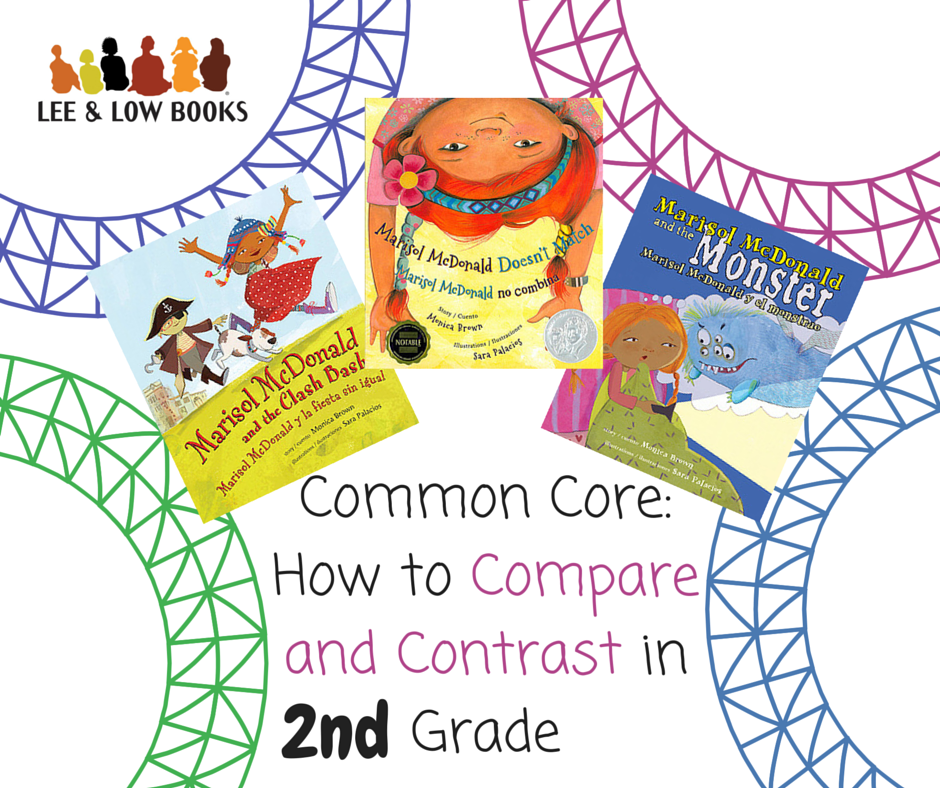 Last week, I presented how to compare and contrast in third grade. In order for second-grade students to be prepared for the increase in rigor and expectations of a formal testing grade the following year, students should practice compare and contrast. This is a complex task, but enables students to demonstrate close reading, comprehension, and interpretation of texts.
Last week, I presented how to compare and contrast in third grade. In order for second-grade students to be prepared for the increase in rigor and expectations of a formal testing grade the following year, students should practice compare and contrast. This is a complex task, but enables students to demonstrate close reading, comprehension, and interpretation of texts.
Below is a comparison of two books by the same author (Monica Brown) and with the same character (Marisol McDonald). I have created sample questions to teach towards and check mastery of each of the broad three Common Core categories. These are by no means the only questions to ask in each category, but these provide an overview of the progression in question complexity and mastery of the texts.
By creating a range of compare and contrast questions across the standards, we are able to differentiate for students within a class, provide extension opportunities for ready learners, or move the whole class from literal- to higher-level thinking over the course of several lessons.
Texts:
Marisol McDonald Doesn’t Match/Marisol McDonald no combina (level: L)
Where’s the Diversity? The NY Times Top 10 Bestsellers List
As we near the end of the 2013, we enter the season when major newspapers and magazines release their “Best of [enter year] lists”. So naturally we were curious about the level of representation of authors of color in last year’s New York Times Top 10 Bestsellers list. We chose to look at their most general bestsellers list, Combined Print & E-Book Fiction (adult), and looked at the top ten books for all 52 weeks of 2012. The results were staggering, if not surprising in light of our past Diversity Gap studies of the Academy Awards, The Tony Awards, The Emmy Awards, the children’s book industry, Sci-Fi and Fantasy Films, US politics, and Silicon Valley where we analyzed yearly/multi-year samplings and found a disturbingly consistent lack of diversity. Continue reading
Whitewashing Book Covers: A Trip to Barnes & Noble Part II
 Allie Jane Bruce is Children’s Librarian at the Bank Street College of Education. She
Allie Jane Bruce is Children’s Librarian at the Bank Street College of Education. She ![]() began her career as a bookseller at Politics and Prose bookstore in Washington, DC, and earned her library degree from Pratt Institute. She tweets from @alliejanebruce and blogs at Bank Street College.
began her career as a bookseller at Politics and Prose bookstore in Washington, DC, and earned her library degree from Pratt Institute. She tweets from @alliejanebruce and blogs at Bank Street College.
Part 1 | Part 2
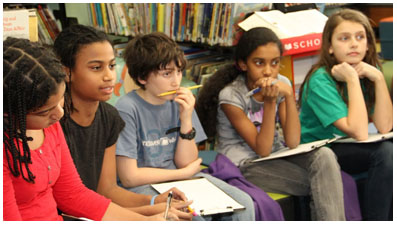
Over the course of the last academic year, I co-taught a year-long unit that allowed a sixth-grade class to explore prejudices in books and the book industry. After studying how book covers and content can marginalize groups (we studied treatments of race, ethnicity, gender, body image, sexuality, class, ability, and more), we took a field trip to Barnes & Noble—by far my favorite piece of the project. The kids exited the store with steam issuing from their ears.

Whitewashing Book Covers: What Do Kids Think? Part I
 Allie Jane Bruce is Children’s Librarian at the Bank Street College of Education. She
Allie Jane Bruce is Children’s Librarian at the Bank Street College of Education. She ![]() began her career as a bookseller at Politics and Prose bookstore in Washington, DC, and earned her library degree from Pratt Institute. She tweets from @alliejanebruce and blogs for Bank Street College.
began her career as a bookseller at Politics and Prose bookstore in Washington, DC, and earned her library degree from Pratt Institute. She tweets from @alliejanebruce and blogs for Bank Street College.
Part 1 | Part 2
In my first year as Children’s Librarian at Bank Street, I worked with two teachers on a project that allowed sixth-graders to explore implicit and explicit biases in publishing. Using book covers as a starting point for discussion, we engaged in conversations about identity, race, ethnicity, sexual orientation, gender, body image, class, and ability as they relate to books and beyond.
Literary Agents Discuss the Diversity Gap in Publishing
Literary agents make up a big part of the publishing machine. Most publishers no longer consider unsolicited submissions, so an agent is a must if you even want to get your foot in the door. Each year, agents review many promising manuscripts and portfolios so it is safe to say they have a good sense of who makes up the talent pool of children’s book publishing. So what kind of diversity are agents seeing? Being that the number of diverse books has not increased in the last eighteen years, in order to understand why this problem persists we decided to ask the gatekeepers.
 Adriana Domínguez is an agent at Full Circle Literary, a boutique literary agency based in San Diego and New York City, offering a unique full circle approach to literary representation. The agency’s experience in book publishing includes editorial, marketing, publicity, legal, and rights, and is used to help build authors one step at a time. Full Circle works with both veteran and debut writers and artists, and has a knack for finding and developing new and diverse talent.
Adriana Domínguez is an agent at Full Circle Literary, a boutique literary agency based in San Diego and New York City, offering a unique full circle approach to literary representation. The agency’s experience in book publishing includes editorial, marketing, publicity, legal, and rights, and is used to help build authors one step at a time. Full Circle works with both veteran and debut writers and artists, and has a knack for finding and developing new and diverse talent.

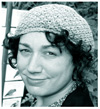 Karen Grencik and Abigail Samoun own Red Fox Literary, a boutique agency representing children’s book authors and illustrators. They offer a dazzling array of talents among their roster of clients, including New York Times and Time magazine Best Book winners, and some of the most promising up-and-coming talents working in the field today. The agency is closed to unsolicited submissions but it does accept queries from attendees at conferences where they present or through industry referrals.
Karen Grencik and Abigail Samoun own Red Fox Literary, a boutique agency representing children’s book authors and illustrators. They offer a dazzling array of talents among their roster of clients, including New York Times and Time magazine Best Book winners, and some of the most promising up-and-coming talents working in the field today. The agency is closed to unsolicited submissions but it does accept queries from attendees at conferences where they present or through industry referrals.
 Lori Nowicki is founder of Painted Words, a literary agency that represents illustrators and authors in the children’s publishing marketplace and beyond. Their goal is to provide the utmost in representation for illustrators and writers while placing a unique emphasis on developing characters, books, and licensed properties.
Lori Nowicki is founder of Painted Words, a literary agency that represents illustrators and authors in the children’s publishing marketplace and beyond. Their goal is to provide the utmost in representation for illustrators and writers while placing a unique emphasis on developing characters, books, and licensed properties.
Do you receive many submissions from authors and illustrators of color? Overall, what percentage of authors and illustrators who submit to you are people of color? Note: Estimations are fine.
AD/Full Circle: I honestly wouldn’t know about percentages, but our agency receives a good number of submissions from authors of color. Proportionally, our agency represents more authors of color than most others. Authors and illustrators who are familiar with our work and/or visit our website know that we welcome diverse points of view, and see that diversity represented in our client list. I will say that I have personally felt for a very long time that there are simply not enough illustrators of color in the marketplace, and I am not quite sure why that is. I am usually very enthusiastic when I receive a query from a talented author/illustrator of color—I wish we received more of those! As a general rule, our agency represents illustrators who are also writers, and such people are difficult to find under any circumstances, as not everyone is equally good at both.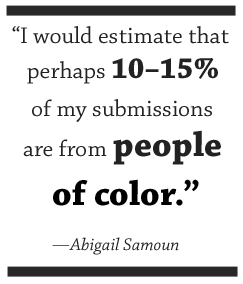
AS/Red Fox Literary: It’s hard to tell how many submissions come from authors and illustrators of color. Most of the time, I haven’t met these authors and illustrators in person so the only way for me to tell what their ethnicity might be is by their name and their choice of subjects, but these can be misleading. I once made an offer on a picture book about an African American family, told in language with a jazzy rhythm, by an author with an African American sounding name and she turned out to be a white librarian. I’d made the assumption, based on the subject and the author’s name, that she would be African American.
Oftentimes, the question of the author’s ethnicity doesn’t enter my mind—unless the subject relates to race, in which case I’ll wonder if the author will have the life experience that can provide a genuine insider’s point-of-view. I would estimate that perhaps 10–15% of my submissions are from people of color.
KG/Red Fox Literary: I have four authors of color on my list of 38 authors, but like Abi says, we never know the ethnicity of an author when they submit to us. The only way I could imagine to gauge it would be by determining how many authors of color attend an SCBWI conference at which I present, comparing that number to the total number of attendees, and then assuming the ratio of submissions to be a similar percentage. At the recent summer conference in LA, I would guesstimate that authors of color made up about 35% of the total number of attendees.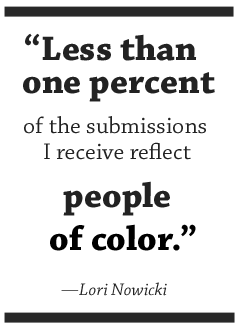
Where’s the Diversity? 5 Reasons Why the US Government Isn’t More Diverse
In our previous diversity studies on the Academy Awards, the Emmy Awards, the children’s book field, The New York Times Top 10 Bestseller List, Sci-Fi and Fantasy Films, the Tony Awards, and Silicon Valley we interviewed people who actively work in television, publishing, and the theater. We attempted to duplicate this approach for our diversity study on US politics, but with the government shutdown, none of the twelve Congresspeople we contacted responded to our efforts to reach out to them. However, we think the numbers speak for themselves: Continue reading




